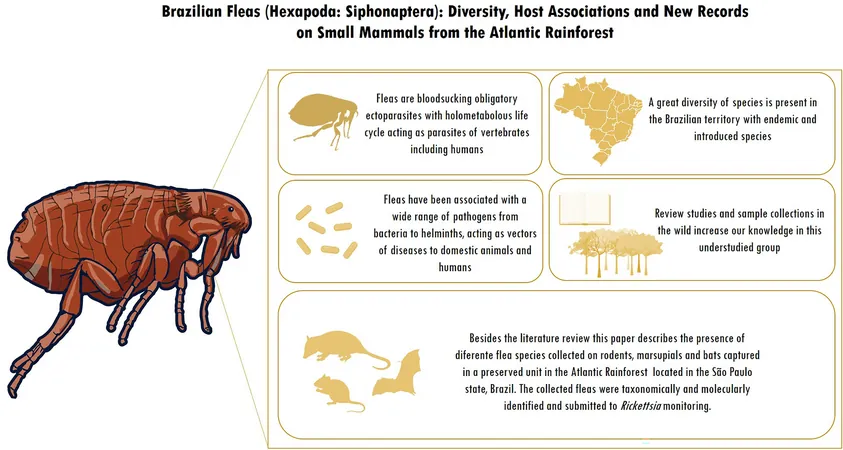
Unveiling the Hidden World of Brazilian Fleas: Complexity, Host Relationships, and Novel Findings from the Atlantic Rainforest
2025-04-03
Author: Ming
A Treasure Trove of Research
This groundbreaking investigation synthesizes data from around 200 scholarly articles focusing on fleas across Brazil, revealing that these insects inhabit all 26 states of the country. The research identifies eight distinct families of fleas, showcasing their adaptability to various hosts and environmental conditions. Key families highlighted include Pulicidae, Ctenophthalmidae, and Rhopalopsyllidae, each with unique characteristics and ecological roles.
Notable Flea Families and Their Health Implications
1. Ceratophyllidae: The Rodent's Companion
The Ceratophyllidae family, with its only representative in Brazil being Nosopsyllus fasciatus, is primarily associated with urban rodents like Rattus norvegicus. This species poses potential health risks as it may carry pathogens such as Rickettsia typhi, which can be spread among rodents but show limited danger to humans.
2. Ctenophthalmidae: The Feathered Friends
Within this extensive family, Brazilian fleas demonstrate a strong preference for marsupials but have also been found on several rodent species. These associations highlight a less understood aspect of flea biology: their ecological interdependencies.
3. Ischnopsyllidae: The Bat Specialists
Fleas belonging to the Ischnopsyllidae family exhibit a remarkable host specificity, largely targeting bats. Their understanding remains limited due to the complexities of their life cycles, which are intricately linked to bat habitats.
A Closer Look at New Findings
In the Atlantic Rainforest of São Paulo, researchers identified 211 fleas from three genera and seven species, unveiling several new host relationships. Notably, the flea P. (P.) bohlsi jordani was documented for the first time in São Paulo, marking a significant addition to the regional flea fauna. Additionally, the identification of Hormopsylla fosteri on bats illustrates the untapped potential for discovering new species interactions within this ecosystem.
The Need for Further Investigation
The findings underscore the importance of continued research on flea diversity in Brazil, particularly within complex biomes like the Atlantic Rainforest. Understanding flea ecology is crucial not only for biodiversity conservation efforts but also for assessing potential health risks posed by flea-borne pathogens.
Conclusion: Fleas, Biodiversity, and Public Health
As miniaturized carriers of disease, fleas are often overlooked in biodiversity studies. However, this research illuminates their role in ecosystems and the interconnectedness of species within Brazil’s unique habitats. Given their impact on both wildlife health and human welfare, intensified research efforts could provide invaluable insights into managing flea populations and mitigating the risks associated with their pathogens. The world of Brazilian fleas is complex yet fascinating, a crucial component of the nation's natural heritage that deserves our attention.



 Brasil (PT)
Brasil (PT)
 Canada (EN)
Canada (EN)
 Chile (ES)
Chile (ES)
 Česko (CS)
Česko (CS)
 대한민국 (KO)
대한민국 (KO)
 España (ES)
España (ES)
 France (FR)
France (FR)
 Hong Kong (EN)
Hong Kong (EN)
 Italia (IT)
Italia (IT)
 日本 (JA)
日本 (JA)
 Magyarország (HU)
Magyarország (HU)
 Norge (NO)
Norge (NO)
 Polska (PL)
Polska (PL)
 Schweiz (DE)
Schweiz (DE)
 Singapore (EN)
Singapore (EN)
 Sverige (SV)
Sverige (SV)
 Suomi (FI)
Suomi (FI)
 Türkiye (TR)
Türkiye (TR)
 الإمارات العربية المتحدة (AR)
الإمارات العربية المتحدة (AR)